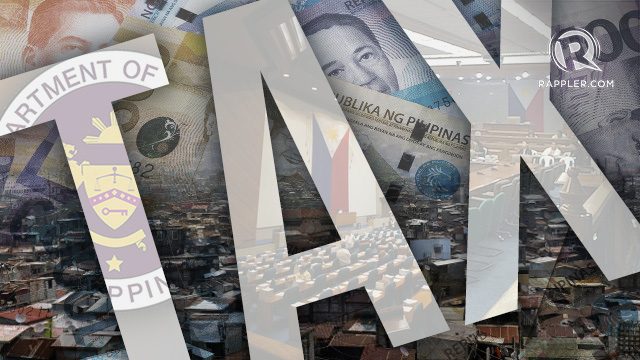SUMMARY
This is AI generated summarization, which may have errors. For context, always refer to the full article.

The Duterte administration appears on the verge of passing the first installment of a comprehensive package of tax reforms long advocated by many in the policymaking community.
There are a variety of motivations for various parts of the reform – on top of fixing the progressivity and fairness of the income tax system and providing relief to the middle class, the government also seeks to generate over P300 billion in new revenues to help fund its infrastructure programs. In addition, concerns over the lack of competitiveness of Philippine tax rates abound, as our corporate income taxes and personal income taxes (top tier) are among the highest in our region.
Unsurprisingly, some of these goals are often conflicting in their expected impact. Increased revenues from indirect taxes are unlikely to reduce inequality. Removing VAT exemptions, while making the tool more efficient, will likely erode government support for key industries unless especially designed subsidies and support packages are ready.
As expected, the difficult trade-offs in the still-evolving tax package are generating mixed reviews from various groups. Yet, our legislators now have a genuine opportunity to form a coherent narrative on how taxing and spending policies could help promote more inclusive development, improving dramatically from what past administrations have been able to achieve.
Rather than simply focus on tax revenues and growth (through infrastructure spending), this administration can address deep-seated inequality in our society and economy through tax and spending reforms combined. In this note I argue that the Senate version of Tax Reform for Acceleration and Inclusion (TRAIN) did not derail TRAIN as some critics suggest – rather it better directed TRAIN toward addressing inequality while preserving some revenues as well.
Tax package evolution
Essentially, the tax reform is comprised of 5 reform packages, and the first package – TRAIN – has the following features. It recalibrates the personal income tax rates to restore progressivity in the income tax schedule, while also introducing and adjusting other taxes to help offset the revenue losses from lower income taxes, and pay for the compensating transfers necessary to protect the poor (e.g., oil tax, automobile levy, sugar-sweetener tax, and removing VAT exemptions).
There are 3 key versions of TRAIN. The DOF version filed with Congress in September 2016; the House of Representatives version (HB 5636) released in May 2017; and the initial Senate version (SB 1592) released earlier this week.

As regards headline revenue targets, the Department of Finance (DOF) version envisioned P157 billion in revenues, while the House version was able to muster revenues of up to P134 billion. An initial estimate of the Senate version pegged its revenues at P59.9 billion. Yet based on recent internal Senate estimates at the time SB 1952 passed the Ways and Means committee level, the revenue potential of the Senate version of TRAIN could be higher, possibly reaching up to P115 billion.
This estimate does not yet include several new taxes proposed by SB 1952, which, among others, include a capital gains tax on non-traded stocks, a tax on cosmetic procedures for aesthetic reasons, and a tax on dividend incomes.
Regardless of where the estimate lies, it is critical to examine the possible trade-off between the goal to hit revenue targets vs the goal to address inequality.
Strengthening compensating transfers
The Senate version under Senator Sonny Angara’s Committee actually addressed inequality by increasing the transfers to poor and low-income households to P300 per household per month, and by fixing the transfer period to 3 years.
Note that the original DOF version gave only P200 per household per month for one year of transfers, while the House version extended this to 4 years but made the transfers optional. The Senate version gives poor and low-income households a slightly longer runway for adjustment.
As an aside, to help ensure that this temporary ramp up of transfers need not be permanent and could help address other equally valid policy goals, the transfer itself can be designed as part of an effort to improve financial inclusion, by providing about half of the country’s population, who are largely unbanked, with bank accounts. (Innovations such as this could be detailed in the implementing rules and regulations of the law, in order to further improve the development yield from this set of reforms.)
Targeted earmarks for human capital and pro-poor investments
Furthermore, all these citizens’ ability to adjust to the new tax regime will also depend critically on their ability to engage in the economy more successfully. Hence, investing part of TRAIN’s revenues in regions and sectors with large numbers of poor and low-income Filipinos can probably help improve on the structural “disconnectedness” of many Filipinos to the country’s growth drivers.
There is an interesting opportunity here as the Senate version also increased the pro-poor earmarks of the tax revenues, with a view to boosting human capital investments and improving pro-poor spending in education and health. These are some of the investments the country would have had to strengthen anyway, so using the revenues in this way could also indirectly help stabilize the country’s fiscal situation (read: prevent politicians from hijacking otherwise non-earmarked revenues and channeling them towards popular but unsustainable spending).
Based on our calculations, the House version of the tax package would have exacerbated inequality as measured by the Gini index, a common measure of income inequality. Applying the measures proposed by HB 5636 to households included in the 2015 Family Income and Expenditure Survey, we found that a pre-tax income Gini of 49.1 worsened to a post-tax Gini of 50.7. Even complete delivery of transfers would not improve upon this dramatically, driving the Gini down to only about 50.
By comparison, the Senate version reduces inequality much further than HB 5636, by bringing the Gini down to about 49.3 – thanks largely to adjustments in personal income tax schedules, much higher per household transfers, and a longer and fixed transfer period.
There is even good reason to believe that the Senate version of the tax package will be able to produce a post-tax reform Gini that will be even better (read: less inequality) compared to the pre-tax reform situation, once its more extensive pro-poor earmarks are fully worked out.
Compared to HB 5636, which allocated only 40% of incremental revenues of the oil excise tax (a projected P29.8 billion for 2018) to a “social benefits program” which includes the cash transfer, SB 1952 temporarily earmarks all incremental revenues to an even more expansive range of social benefits and investments for poor and near-poor households.
Strong targeting toward sectors (e.g., coconut and fisheries) and regions (e.g., parts of the Visayas and Mindanao) with large numbers of poor and low-income Filipinos could augment the transfers and directly address deep-seated factors behind inequality and poverty in the country.
Balancing efficiency and equity
While not necessarily ideal from the point of view of flexible public finance policy, pragmatic earmarking could nevertheless represent a middle ground to help boost revenues while also addressing inequality. Given still considerable underspending by government[1] and the still large fiscal headroom provided by development assistance and some borrowing, the argument that the government’s infrastructure program will be severely lacking in funds – if the tax package is not passed (or if it is passed and much of it temporarily earmarked) – appears to be less compelling.
A middle ground position here would probably involve earmarking toward social (read: pro-poor) spending during a fixed and temporary period, after which the revenues could then revert back to the general fund of the Philippine government.
By channeling those resources toward sectors and regions with many economically disconnected poor and low-income Filipinos, the tax reform could help address inclusive growth in ways that past public finance reforms may have been less able to address. – Rappler.com
*The views expressed are those of the authors and do not necessarily reflect the views and policies of the Ateneo de Manila University. This article draws on a draft working paper prepared by the Ateneo Policy Center. +AMDG
[1] Paolo Romero, “Underspending still plagues government,” Philippine Star, 18 September 2017, (Accessed September 17, 2017).
Add a comment
How does this make you feel?
There are no comments yet. Add your comment to start the conversation.